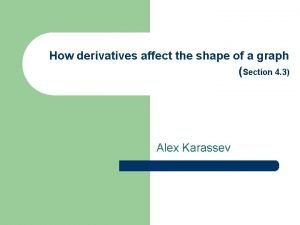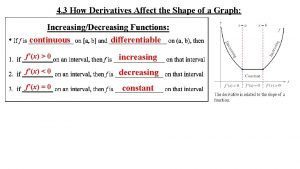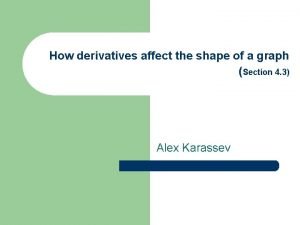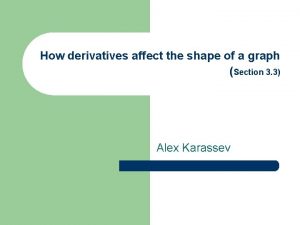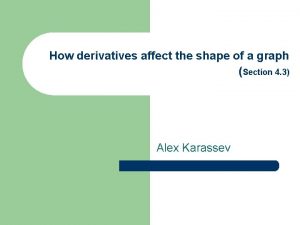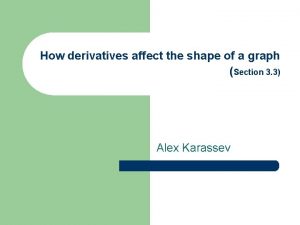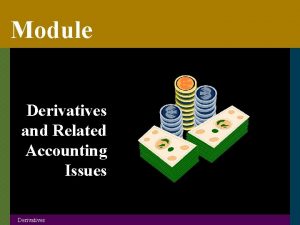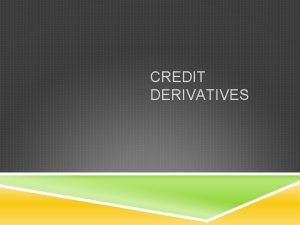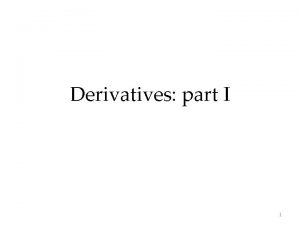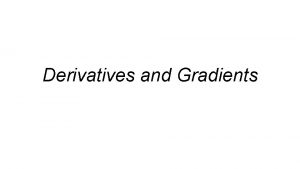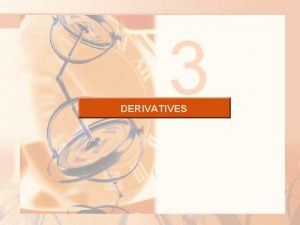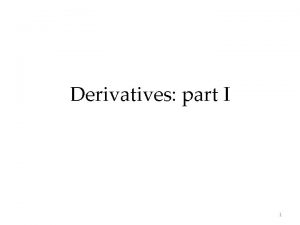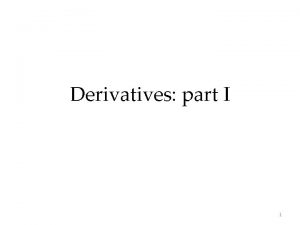How derivatives affect the shape of a graph















- Slides: 15

How derivatives affect the shape of a graph (Section 4. 3) Alex Karassev

First and second derivatives l l f ′ tells us about intervals of increase and decrease f ′′ tells us about concavity

First derivative: Intervals of Increase / Decrease

Increasing / Decreasing Slope of tangent line slope > 0 y = f(x) slope < 0 decr. incr. x

Increasing / Decreasing Test Derivative f ′ (x) > 0 y = f(x) f ′ (x) < 0 decr. incr. x

Change of behavior f can change from increasing to decreasing and vice versa: • at the points of local max/min (i. e. at the critical numbers) • at the points where f is undefined f ′ (x) > 0 y = f(x) f ′ (x) < 0 decr. incr. x

Local max/min: 1 st derivative test loc. max loc. min. f ′ (x) < 0 decr. y = f(x) l Let c be a critical number l How do we determine whether it is loc. min or loc. max or neither? f ′ (x) > 0 c incr. x l If f ′ changes from negative to positive at c, it is loc. min. l If f ′ changes from positive to negative at c, it is loc. max. l If f ′ does not change sign at c, it is neither (e. g. f(x) = x 3, c =0)

Second derivative: Concavity

Concavity: definition Graph lies above tangent lines: concave upward Graph lies below tangent lines: concave downward

Concavity: example Inflection points up down y = f(x) up down up

Concavity test: use f′′ (x) > 0 Graph lies above tangent lines: concave upward f′′ (x) < 0 Graph lies below tangent lines: concave downward Inflection points: Numbers c where f′′(c) = 0 are "suspicious" points

Change of concavity f can change from concave upward to concave downward and vice versa: • at inflection points (check f ′′ (x) = 0) y = f(x) • at the points where f is undefined up down up

Local max/min: 2 nd derivative test loc. max f ′′ (c) < 0 loc. min. f ′′ (c) > 0 c y = f(x) x l Suppose f ′ (c) = 0 l How do we determine whether it is loc. min or loc. max or neither? NOTE: tangent line at (c, f(c)) is horizontal l ⇒ loc. min. If f ′′ (c) < 0 the graph lies below the tangent ⇒ loc. max. l If f ′′ (c) = 0 the test is inconclusive (use 1 st deriv. test instead!) l If f ′′ (c) > 0 the graph lies above the tangent

Comparison of 1 st and 2 nd derivative tests for local max/min l Second derivative test is faster then 1 st derivative test (we need to determine where f′(c) = 0 and then just compute f′′(c) at each such c) l Second derivative test can be generalized on the case of functions of several variables l However, when f′′(c) = 0, the second derivative test is inconclusive (for example, (0, 0) is an inflection point for f(x) = x 3, while for x 4 it is a point of local minimum, and for –x 4 it is a point of local maximum)

Examples l l Sketch the graph of function y = x 4 – 6 x 2 Use the second derivative test to find points of local maximum and minimum of f(x) = x/(x 2+4)
 How derivatives affect the shape of a graph
How derivatives affect the shape of a graph How derivatives affect the shape of a graph
How derivatives affect the shape of a graph Derivatives and the shape of a graph
Derivatives and the shape of a graph Drag divergence mach number
Drag divergence mach number Shape matching and object recognition using shape contexts
Shape matching and object recognition using shape contexts Bolongie
Bolongie Hát kết hợp bộ gõ cơ thể
Hát kết hợp bộ gõ cơ thể Frameset trong html5
Frameset trong html5 Bổ thể
Bổ thể Tỉ lệ cơ thể trẻ em
Tỉ lệ cơ thể trẻ em Gấu đi như thế nào
Gấu đi như thế nào Tư thế worms-breton
Tư thế worms-breton Alleluia hat len nguoi oi
Alleluia hat len nguoi oi Các môn thể thao bắt đầu bằng tiếng nhảy
Các môn thể thao bắt đầu bằng tiếng nhảy Thế nào là hệ số cao nhất
Thế nào là hệ số cao nhất Các châu lục và đại dương trên thế giới
Các châu lục và đại dương trên thế giới
